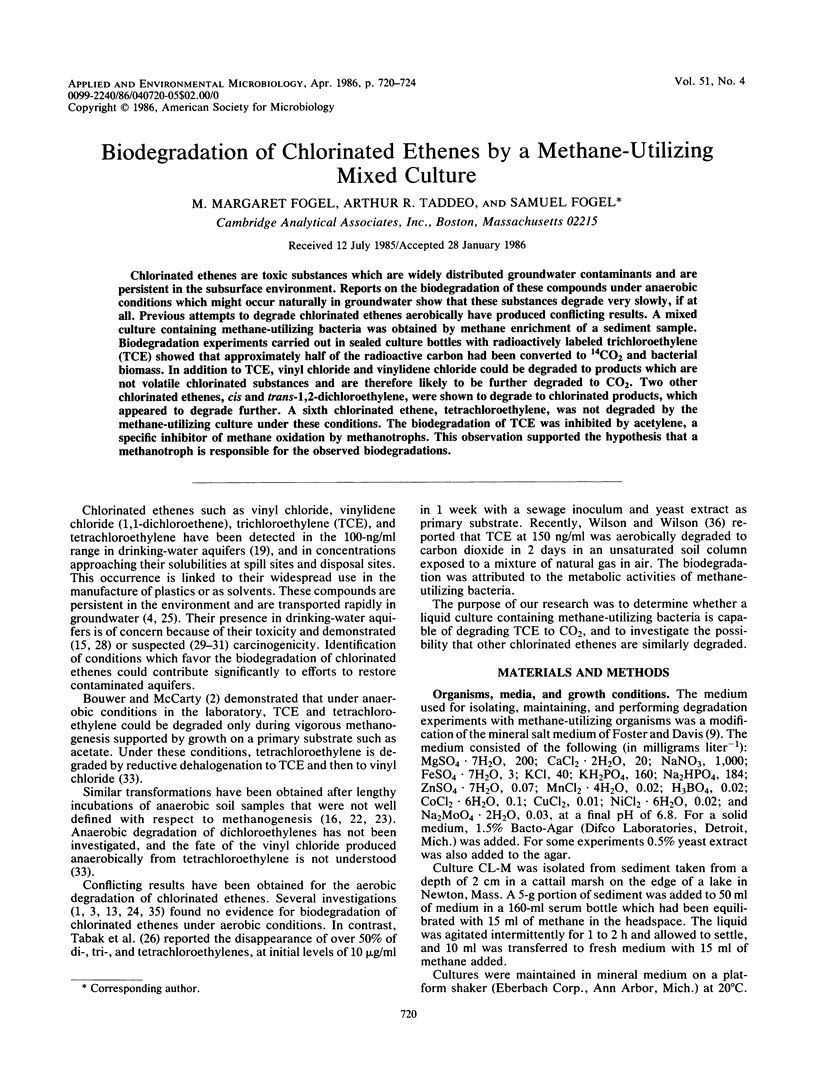Abstract
Chlorinated ethenes are toxic substances which are widely distributed groundwater contaminants and are persistent in the subsurface environment. Reports on the biodegradation of these compounds under anaerobic conditions which might occur naturally in groundwater show that these substances degrade very slowly, if at all. Previous attempts to degrade chlorinated ethenes aerobically have produced conflicting results. A mixed culture containing methane-utilizing bacteria was obtained by methane enrichment of a sediment sample. Biodegradation experiments carried out in sealed culture bottles with radioactively labeled trichloroethylene (TCE) showed that approximately half of the radioactive carbon had been converted to 14CO2 and bacterial biomass. In addition to TCE, vinyl chloride and vinylidene chloride could be degraded to products which are not volatile chlorinated substances and are therefore likely to be further degraded to CO2. Two other chlorinated ethenes, cis and trans-1,2-dichloroethylene, were shown to degrade to chlorinated products, which appeared to degrade further. A sixth chlorinated ethene, tetrachloroethylene, was not degraded by the methane-utilizing culture under these conditions. The biodegradation of TCE was inhibited by acetylene, a specific inhibitor of methane oxidation by methanotrophs. This observation supported the hypothesis that a methanotroph is responsible for the observed biodegradations.
Full text
PDF




Selected References
These references are in PubMed. This may not be the complete list of references from this article.
- Bouwer E. J., McCarty P. L. Transformations of 1- and 2-carbon halogenated aliphatic organic compounds under methanogenic conditions. Appl Environ Microbiol. 1983 Apr;45(4):1286–1294. doi: 10.1128/aem.45.4.1286-1294.1983. [DOI] [PMC free article] [PubMed] [Google Scholar]
- Chiou C. T., Peters L. J., Freed V. H. A physical concept of soil-water equilibria for nonionic organic compounds. Science. 1979 Nov 16;206(4420):831–832. doi: 10.1126/science.206.4420.831. [DOI] [PubMed] [Google Scholar]
- Colby J., Dalton H. Some properties of a soluble methane mono-oxygenase from Methylococcus capsulatus strain Bath. Biochem J. 1976 Aug 1;157(2):495–497. doi: 10.1042/bj1570495. [DOI] [PMC free article] [PubMed] [Google Scholar]
- Colby J., Dalton H., Whittenbury R. An improved assay for bacterial methane mono-oxygenase: some properties of the enzyme from Methylomonas methanica. Biochem J. 1975 Nov;151(2):459–462. doi: 10.1042/bj1510459. [DOI] [PMC free article] [PubMed] [Google Scholar]
- Dalton H., Stirling D. I. Co-metabolism. Philos Trans R Soc Lond B Biol Sci. 1982 Jun 11;297(1088):481–496. doi: 10.1098/rstb.1982.0056. [DOI] [PubMed] [Google Scholar]
- Fogel S., Lancione R. L., Sewall A. E. Enhanced biodegradation of methoxychlor in soil under sequential environmental conditions. Appl Environ Microbiol. 1982 Jul;44(1):113–120. doi: 10.1128/aem.44.1.113-120.1982. [DOI] [PMC free article] [PubMed] [Google Scholar]
- Foster J. W., Davis R. H. A methane-dependent coccus, with notes on classification and nomenclature of obligate, methane-utilizing bacteria. J Bacteriol. 1966 May;91(5):1924–1931. doi: 10.1128/jb.91.5.1924-1931.1966. [DOI] [PMC free article] [PubMed] [Google Scholar]
- Guengerich F. P., Crawford W. M., Jr, Watanabe P. G. Activation of vinyl chloride to covalently bound metabolites: roles of 2-chloroethylene oxide and 2-chloroacetaldehyde. Biochemistry. 1979 Nov 13;18(23):5177–5182. doi: 10.1021/bi00590a023. [DOI] [PubMed] [Google Scholar]
- Higgins I. J., Best D. J., Hammond R. C. New findings in methane-utilizing bacteria highlight their importance in the biosphere and their commercial potential. Nature. 1980 Aug 7;286(5773):561–564. doi: 10.1038/286561a0. [DOI] [PubMed] [Google Scholar]
- Higgins I. J., Quayle J. R. Oxygenation of methane by methane-grown Pseudomonas methanica and Methanomonas methanooxidans. Biochem J. 1970 Jun;118(2):201–208. doi: 10.1042/bj1180201. [DOI] [PMC free article] [PubMed] [Google Scholar]
- Hou C. T., Patel R., Laskin A. I., Barnabe N. Microbial oxidation of gaseous hydrocarbons: epoxidation of C2 to C4 n-alkenes by methylotrophic bacteria. Appl Environ Microbiol. 1979 Jul;38(1):127–134. doi: 10.1128/aem.38.1.127-134.1979. [DOI] [PMC free article] [PubMed] [Google Scholar]
- LEADBETTER E. R., FOSTER J. W. Studies on some methane-utilizing bacteria. Arch Mikrobiol. 1958;30(1):91–118. doi: 10.1007/BF00509229. [DOI] [PubMed] [Google Scholar]
- Malashenko Iu R., Romanovskaia V. A., Bogachenko V. N., Kryshtab T. P. Vliianie organicheskikh veshchestv na assimiliatsiiu metana obligatnymi metilotrofami. Mikrobiologiia. 1974 Mar;43(2):343–348. [PubMed] [Google Scholar]
- Miller R. E., Guengerich F. P. Oxidation of trichloroethylene by liver microsomal cytochrome P-450: evidence for chlorine migration in a transition state not involving trichloroethylene oxide. Biochemistry. 1982 Mar 2;21(5):1090–1097. doi: 10.1021/bi00534a041. [DOI] [PubMed] [Google Scholar]
- Pearson C. R., McConnell G. Chlorinated C1 and C2 hydrocarbons in the marine environment. Proc R Soc Lond B Biol Sci. 1975 May 20;189(1096):305–332. doi: 10.1098/rspb.1975.0059. [DOI] [PubMed] [Google Scholar]
- Tonge G. M., Harrison D. E., Higgins I. J. Purification and properties of the methane mono-oxygenase enzyme system from Methylosinus trichosporium OB3b. Biochem J. 1977 Feb 1;161(2):333–344. doi: 10.1042/bj1610333. [DOI] [PMC free article] [PubMed] [Google Scholar]
- Vogel T. M., McCarty P. L. Biotransformation of tetrachloroethylene to trichloroethylene, dichloroethylene, vinyl chloride, and carbon dioxide under methanogenic conditions. Appl Environ Microbiol. 1985 May;49(5):1080–1083. doi: 10.1128/aem.49.5.1080-1083.1985. [DOI] [PMC free article] [PubMed] [Google Scholar]
- Wilkinson T. G., Harrison D. E. The affinity for methane and methanol of mixed cultures grown on methane in continuous culture. J Appl Bacteriol. 1973 Jun;36(2):309–313. doi: 10.1111/j.1365-2672.1973.tb04107.x. [DOI] [PubMed] [Google Scholar]
- Wilson J. T., Wilson B. H. Biotransformation of trichloroethylene in soil. Appl Environ Microbiol. 1985 Jan;49(1):242–243. doi: 10.1128/aem.49.1.242-243.1985. [DOI] [PMC free article] [PubMed] [Google Scholar]
- Zhao S. J., Hanson R. S. Variants of the Obligate Methanotroph Isolate 761M Capable of Growth on Glucose in the Absence of Methane. Appl Environ Microbiol. 1984 Oct;48(4):807–812. doi: 10.1128/aem.48.4.807-812.1984. [DOI] [PMC free article] [PubMed] [Google Scholar]


